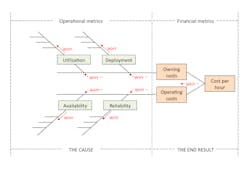We are very good at collecting data when the transaction in question has a dollar sign attached to it. Every transaction on your credit card is recorded in detail and processed almost instantaneously because it is a commercial transaction. Transactions that do not have dollar signs attached to them are different. Operational metrics that measure performance are nice to have but, unlike financial metrics, are not a requirement. We seldom measure downtime, but we know to the penny how much we spent on the bolt that broke.
The diagram above shows four important operational metrics that can be used to measure machine performance.
The fact that accurate and timely cost data is available causes us to place too much emphasis on cost in our reporting and decision making. Yes, cost is critically important, and knowing and managing your cost is the price of admission to the construction industry. We must, however, understand that cost is the end result of the way we solve our problems, not the cause of our problems. The only way you resolve a cost overrun is to find out why and fix the problem. You cannot reduce an overrun in repair costs by putting away your checkbook and not spending on repair parts and labor. You solve the problem by asking “Why” questions to identify the root cause and improve reliability and availability.
The diagram shows how the system works as we move from right to left. The key financial metric, cost per hour, is used to ask our first question: Is there a problem with owning cost or is there a problem with operating cost? These financial metrics measure the end result. They are often in place and are calculated on a routine basis by coding invoices, work orders, and time cards. Accounting systems and standards cause costs to be analyzed and processed with the discipline needed to flourish in the commercial world. We measure the end result, but we are seldom in a good position to answer the “Why” questions needed to solve problems and improve performance.
This is where operational metrics come into play. They measure how we are doing our job and how the machines are performing. They lie at the beginning of the root-cause analysis that we need in order to ask tough “Why” questions and solve practical day-to-day problems.
Operational metrics do not enjoy the level of standardization and acceptance that the accounting profession has brought to financial metrics, and above all, the required data is seldom part of a commercial transaction. We record the time a mechanic works on a machine because we must pay a mechanic. Yet we do not record the time the machine is down or awaiting repair despite the fact that downtime is a critically important operational metric.
The diagram above shows four important operational metrics that can be used to measure machine performance. Two—deployment and utilization—affect owning costs, and two—reliability and availability—affect operating cost. Let’s go through them one at a time and see how they can be used to perform the root-cause analysis needed to attack the causes of cost and improve performance. We cannot handle every situation within the length of this article, but we can give you the inspiration needed to work on the details within your organization.
Deployment. Deployment measures the amount of time (weeks per year) that a machine spends on site and is expected to work. This is critically important because a machine that is not deployed to a site is not contributing to the enterprise and is most certainly not in a position to recover any of its fixed owning costs. We absolutely cannot afford assets—whether fully depreciated or not—that sit in the yard and keep the fence warm. Everything should be out there working as much as possible, and deployment measures whether or not this is the case.
For more asset management, visit www.ConstructionEquipment.com/Institute.
The deployment metric will prompt “Why” questions relating to the size and composition of the fleet, the wisdom of the original acquisition decision, and the wisdom of disposing of the machine sooner rather than later. It is impossible to recover the owning cost on an undeployed unit. Know that you can always bring in a rental to cover a peak demand—if and when it occurs. You absolutely do not want your money invested in the bank of undeployed equipment.
Recording the location and time-on-site data needed to calculate deployment should not be a problem. Telematics and electronic dispatch board data make it relatively simple. It is a matter of calculating the metric and using it as the first step in optimizing fixed-cost recovery.
Utilization. Utilization measures the number of hours a machine actually works (hours per week) and contributes to accomplishing work. As with deployment, it is a prerequisite for the recovery of fixed owning costs. Nothing influences owning cost per hour more than utilization.
Utilization is, in the vast majority of cases, a function of job-site management. The “Why” questions will relate to job planning as well as the means, methods, sequence, and flow of operations. Tightly sequenced jobs, jobs that rely on a lot of coordination with others, and jobs where continuity of work is a problem produce low levels of utilization. Job planning and resource utilization is not as easy as it was when the world was a simpler place. Equipment utilization has come to be a major construction cost risk.
Recording the time a machine actually works and contributes to accomplishing work is often tied to the daily recording needed for payroll and job costing. Hours-worked data also drives the job-charging process, and thus it is relatively easy to produce the utilization metrics needed to ask critical “Why” questions and optimize fixed-cost recovery.
Reliability. Reliability measures the frequency with which a machine breaks down, delaying or disrupting a production operation. It can be defined as the number of reported emergency down (RED) events per 1,000 hours and is the key driver of operating costs as well as the principal source of the significant collateral costs associated with disrupted production. Machines cannot achieve operating cost goals if they break down too often. Repair costs under unplanned emergency conditions are just too high, and repair-after-failure actions invariably cost much more than preventive repair-before-failure actions.
The “Why” questions arising from low reliability point toward both preventive and condition-based maintenance. In today’s world, there is little reason to experience a RED event and there is little reason to spend more than a small portion of the maintenance budget on repair-after-failure actions.
Appropriately coded work orders will provide the data needed to measure reliability and calculate this critical operational metric. It is strange to think that we spend substantial money on maintenance programs designed to prevent RED events and yet we seldom if ever measure the frequency with which we experience RED events.
Availability. Availability measures the amount of time the machine is able to work as a percentage of the time it is required to work. It differs from reliability in that it measures the duration of downtime as opposed to the frequency of down events. As with reliability, it is a key driver of operating cost: The longer the machine is down, the more you will likely spend on repair parts and labor, and the fewer working hours you have to recover the costs. “Why” questions seeking to address operating-cost problems frequently point to lack of availability as a cause. “Why” questions on availability often point to root causes such as poor maintenance, unplanned failures, age, application, and operation.
The down-hour data needed to calculate availability is extremely difficult to obtain. Telematics won’t give it to you directly, time cards are often inaccurate, and mechanic’s time does not tell the full story. A good tag out and return to service system will help. Again, it is strange that we spend substantial money keeping our machines up and running and yet we seldom have a systematic way of recording downtime and measuring success.
The financial metrics—owning cost and operating cost per hour—do little more than trigger required action. Operational metrics, deployment, utilization, reliability, and availability help tell you why and direct your action to the right place. Success is less about cost and more about having the operational metrics needed to ask the right questions, find the root cause, and improve performance.





